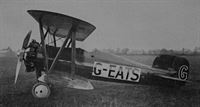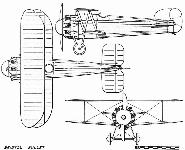
Описание
Страна: Великобритания
Год: 1919
Единственный экземпляр
C.Barnes Bristol Aircraft since 1910 (Putnam)
The Bristol Bullet
The Bullet was designed by Capt. Barnwell, at the instigation of Roy Fedden, with the twofold purpose of providing a test-bed for the Cosmos Jupiter engine on which the effects of high-speed manreuvres could be studied, and of bringing the Company's name into the public eye in international races. It was one of the fastest aeroplanes of its day, its top speed being little short of 160 m.p.h. It was a single-seater biplane of great strength and exquisite finish; the wing and tailplane spars were all duplicated to permit the use of thin low-drag aerofoils without sacrificing stiffness. The fuselage was a conventional four-longeron tie-rod-braced girder faired to a circular cross-section to blend with the radial engine, which was cowled similarly to that of the fourth Badger (J6492); the latter had just begun flight tests when the Bullet design was finalised in August 1919. In order to keep the landing speed below 50 m.p.h., Barnwell chose a wing area of295 sq. ft.; the wings were of nearly equal span, but the upper was greater in chord than the lower; ailerons were fitted only to the upper wing, and the wing roots were joined to each other and to the cabane struts on the aircraft centre line. Only one Bullet, No. 5869, was built. It was exhibited at the Paris Salon in December 1919, but the Cosmos Jupiter engine was a partial mock-up, with no pistons or crankshaft and only a dummy wooden crankcase with a plain airscrew shaft through it; no complete engine could be spared for exhibition at that date.
No flight engine was in fact available for it until June 1920, when it was registered G-EATS; by this time an improved cowling had been developed for the Badger, having raised shoulders between the cylinder heads; a similar cowling was installed on the Bullet, which first appeared in the Aerial Derby on 24 July 1920, flown by Uwins. Although he achieved the third fastest time round the course, his average speed of 129 m.p.h. was disappointing and Barnwell decided that fuselage drag could be reduced if the engine were almost submerged. This required a larger diameter forward, but wind tunnel tests confirmed the improvement, and a large hemispherical spinner was designed to match the revised cowling. When flown again the improvement was less than expected and the wing area was then reduced to 180 sq. ft., since other racing biplanes were being handled safely at a wing loading of 12 lb. per sq. ft. The ailerons were relocated on the lower wing, where control circuit friction was less, and the lower wing was given a pronounced dihedral angle. The new wings, being reduced in both span and chord, needed a correspondingly smaller gap, and this brought the upper wing roots near enough to the fuselage to permit the cabane to be reduced to a pair of short single struts on the centre-line. The tailplane area was reduced to match the new wings and the revised design was completed in February 1921.
By this time it was urgently necessary to step up the hours of flight testing of the Jupiter engine, now a Bristol product, in order to obtain Air Ministry approval as soon as possible. The Bullet shared this task with the fourth Badger and rarely left the neighbourhood of Filton, except for the 1921 Aerial Derby, in which Uwins flew it round the course in the second fastest time; he finished fourth at an average speed of 141 m.p.h., being outpaced only by the Napier Lion-engined Gloster Mars I. Minor refinements were made during the next 12 months, but the biggest improvement came from simply leaving off the spinner when it was flown in the 1922 Aerial Derby by Rollo de Raga Raig, who gained second place at an average speed of 145 m.p.h. In January 1923 the cowling was further improved and a long-stroke oleo undercarriage was fitted to cater for landing with maximum fuel in the King's Cup Race. The Bullet was expected to exceed 175 m.p.h. with an up-rated Jupiter IV and was entered in both the 1923 Aerial Derby and King's Cup Races, but its intended pilot, Leslie Foot, was killed six weeks earlier in the Grosvenor Cup Race and the Company then withdrew from racing for two years. After Foot's death the Bullet was stored for a time, being finally scrapped in 1924, although its registration was not cancelled until April 1925.
SPECIFICATION AND DATA
Type: Bullet
Manufacturers: The Bristol Aeroplane Co. Ltd., Filton, Bristol
Power Plant: One 450 hp Bristol Jupiter II
Span: (early) 31 ft 2 in; (late) 22 ft 4 in
Length: 24 ft 1 in
Height: (early) 9 ft 8 in; (late) 8 ft 10 in
Wing Area: (early) 295 sq ft; (late) 180 sq ft
Empty Weight: 1,800lb
All-up Weight: 2,300lb
Max. Speed: (early) 155 mph; (late) 170 mph
Accommodation: Pilot only
Production: One only
Sequence No.: 5869
Описание:
- C.Barnes Bristol Aircraft since 1910 (Putnam)
- A.Jackson British Civil Aircraft since 1919 vol.1 (Putnam)
- Журнал Flight
Фотографии
-
C.Barnes - Bristol Aircraft since 1910 /Putnam/
The Bristol Bullet G-EATS in the original form in which Capt C. F. Uwins flew it on 24 July, 1920, in the Aerial Derby at Filton.
-
C.Barnes - Bristol Aircraft since 1910 /Putnam/
The Bullet in its final form at Croydon in September 1922.
-
Журнал - Flight за 1919 г.
The Bristol Racer, 450 h.p. Cosmos "Jupiter"
-
C.Barnes - Bristol Aircraft since 1910 /Putnam/
Bristol Bullet








